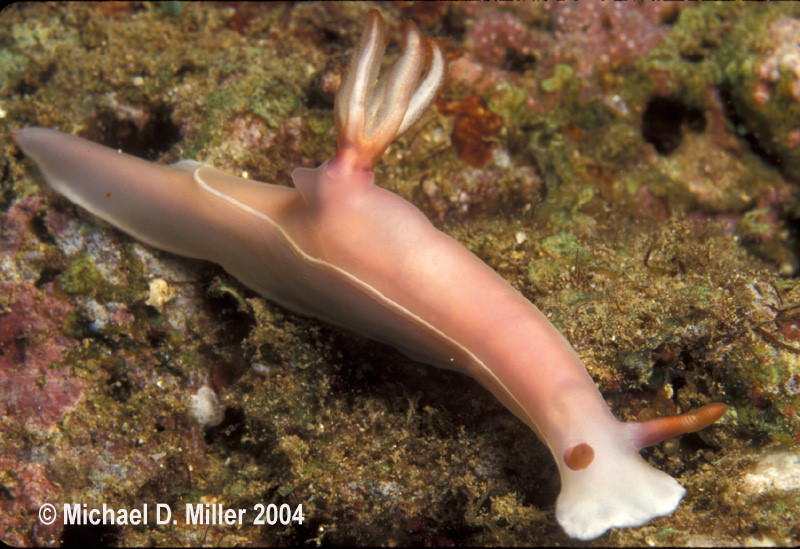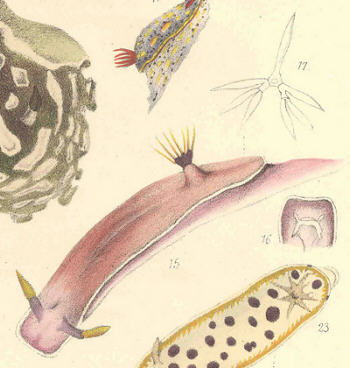 |
Hypselodoris bullocki
Photo courtesy of WebmasterBatangas, Philipppines, 1995
Hypselodoris bullocki(Collingwood, 1881)
Or….. Will the real H. bullocki please stand up?
Over the last several years there has been much discussion and arguing over who is the real Hypselodoris bullocki. There have been so many postings on the Sea Slug Forum that Bill Rudman has had to add multiple pages. Debelius shows several colors he calls H. bullocki , which likely are not. Webmaster Mike has run this species previously as a BOW . Nathalie Yonow has described one of the color variations as Hypselodoris apolegma .
Just this past week Lindsay Warren sent Webmaster Mike a copy of Collingwood's original description and the color plate show above. We repeat the text below. Although this description was based on a single specimen, it clearly indicates the H. bullocki, whether creamy white (as seen above) or deeper pink/purple, represent specimens with the thin white marginal band, and orange-yellow gills with an amethyst base.
Also of note is who "Bullock" was.
Hypselodoris bullocki [=Chromodoris bullocki,
Coll., n. sp. (Plate IX, figs. 15-17)] from Collingwood, 1881.

Text from Collingwood, 1881: "Length: 2 ¾ inches. Body rather compressed, translucent. Mantle broad and square in front, narrowing behind, and having the sides and posterior portion of the foot uncovered. Dorsal tentacles 4/10 inch long, slender, consisting of a cylindrical pedicle, smooth, and supporting a club-shaped, spirally laminated head. Branchiae consisting of seven simple leaflets arranged in three sets, and arising from a thick retractile peduncle situated in a cylindrical sheath of the mantle, a little more than halfway from the anterior edge of the mantle to the posterior point of the foot. This peduncle gives off one leaflet in front, and two lateral branches, each of which gives rise to three leaflets. The leaflets are angular posteriorly, and edged with delicate papillae upon the anterior aspect. Head concealed by the mantle, and bearing two small oral tentacles. Foot long and fleshy, extending nearly three fourths of an inch beyond the posterior edge of the mantle. Colour and general appearance. Body semitransparent. Head of a deep amethystine tint, shading behind the dorsal tentacles through paler amethyst to reddish upon the back; an opaque white edging all round the mantle. Peduncles of the tentacles and branchiae deep amethyst; laminated portion of the tentacles and leaflets of the branchiae deep orange-yellow. Foot pale amethyst, becoming deeper at the posterior portion, where it is as deep as at the anterior part of the mantle. Of this magnificent species I dredged one specimen in the 60 fathoms, off Recruit Island, North Pacific, about 150 miles NE of Formosa. It was quite lively, and lived several days, moving freely about, and floating foot uppermost, but never showing any tendency to leave the surface of the water. I have named it after Captain Charles Bullock, R.N., a gentleman greatly interested in these studies, and from whom I met with much assistance and courtesy."
|
Reference:
Collingwood, C., 1881, On some New Species of Nudibranchiate Mollusca from the Eastern Seas in Transactions of the Linnean Society London, Zoological Series 2, Vol. 2, pp 123-140)
Danville, Calif
Aug., 2004
Taxonomic information courtesy of:

David W. Behrens
Author:
Pacific Coast Nudibranchs
Send Dave mail at dave@seachallengers.com
|
